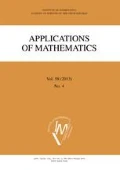Abstract
In this paper we consider two versions of the Collatz-Wielandt quotient for a pair of nonnegative operators A, B that map a given pointed generating cone in the first space into a given pointed generating cone in the second space. If the two spaces and two cones are identical, and B is the identity operator, then one version of this quotient is the spectral radius of A. In some applications, as commodity pricing, power control in wireless networks and quantum information theory, one needs to deal with the Collatz-Wielandt quotient for two nonnegative operators. In this paper we treat the two important cases: a pair of rectangular nonnegative matrices and a pair of completely positive operators. We give a characterization of minimal optimal solutions and polynomially computable bounds on the Collatz-Wielandt quotient.
Similar content being viewed by others
References
C. Avin, M. Borokhovich, Y. Haddad, E. Kantor, Z. Lotker, M. Parter, D. Peleg: Generalized Perron-Frobenius theorem for multiple choice matrices, and applications. Proceedings of the 24th Annual ACM-SIAM Symposium on Discrete Algorithms, SODA 2013. SIAM, Philadelphia, 2013, pp. 478–497.
C. Avin, M. Borokhovich, Y. Haddad, E. Kantor, Z. Lotker, M. Parter, D. Peleg: Generalized Perron-Frobenius theorem for nonsquare matrices. Available at https://arxiv.org/abs/1308.5915 (2013), 55 pages.
A. Berman, R. J. Plemmons: Nonnegative Matrices in Mathematical Sciences. Computer Science and Applied Mathematics. Academic Press, New York, 1979.
G. Boutry, M. Elad, G. H. Golub, P. Milanfar: The generalized eigenvalue problem for nonsquare pencils using a minimal perturbation approach. SIAM J. Matrix Anal. Appl. 27 (2005), 582–601.
S. Boyd, L. Vandenberghe: Convex Optimization. Cambridge University Press, New York, 2004.
M.-D. Choi: Completely positive linear maps on complex matrices. Linear Algebra Appl. 10 (1975), 285–290.
D. Chu, G. H. Golub: On a generalized eigenvalue problem for nonsquare pencils. SIAM J. Matrix Anal. Appl. 28 (2006), 770–787.
L. Collatz: Einschliessungssatz für die charakteristischen Zahlen von Matrizen. Math. Z. 48 (1942), 221–226. (In German.)
I. Erdelyi: On the matrix equation Ax = λBx. J. Math. Anal. Appl. 17 (1967), 119–132.
S. Friedland: Characterizations of the spectral radius of positive operators. Linear Algebra Appl. 134 (1990), 93–105.
S. Friedland: Characterizations of spectral radius of positive operators on C* algebras. J. Funct. Anal. 97 (1991), 64–70.
S. Friedland: Matrices: Algebra, Analysis and Applications. World Scientific, Hackensack, 2016.
S. Friedland, R. Loewy: On the extreme points of quantum channels. Linear Algebra Appl. 498 (2016), 553–573.
G. F. Frobenius: Über Matrizen aus positiven Elementen. Berl. Ber. 1908 (1908), 471–476. (In German.)
G. F. Frobenius: Über Matrizen aus positiven Elementen II. Berl. Ber. 1909 (1909), 514–518. (In German.)
G. F. Frobenius: Über Matrizen aus nicht negativen Elementen. Berl. Ber. 1912 (1912), 456–477. (In German.)
F. R. Gantmacher: The Theory of Matrices. Vol. 1. Chelsea Publishing, New York, 1959.
F. R. Gantmacher: The Theory of Matrices. Vol. 2. Chelsea Publishing, New York, 1959.
G. H. Golub, C. F. Van Loan: Matrix Computations. Johns Hopkins Studies in the Mathematical Sciences. Johns Hopkins University Press, Baltimore, 2013.
M. Grötschel, L. Lovász, A. Schrijver: Geometric Algorithms and Combinatorial Optimization. Algorithms and Combinatorics 2. Springer, Berlin, 1988.
M. B. Hastings: Superadditivity of communication capacity using entangled inputs. Nature Phys. 5 (2009), 255–257.
A. S. Holevo: The additivity problem in quantum information theory. Proceedings of the International Congress of Mathematicians (ICM). Vol. III. European Mathematical Society, Zürich, 2006, pp. 999–1018.
A. S. Holevo: Quantum Systems, Channels, Information: A Mathematical Introduction. De Gruyter Studies in Mathematical Physics 16. DeGruyter, Berlin, 2012.
R. A. Horn, C. R. Johnson: Matrix Analysis. Cambridge University Press, Cambridge, 2013.
S. Karlin: Positive operators. J. Math. Mech. 8 (1959), 905–937.
M. G. Kretn, M. A. Rutman: Linear operators leaving invariant cone in a Banach space. Usp. Mat. Nauk 3 (1948), 3–95. (In Russian.)
L. Lovász: An Algorithmic Theory of Numbers, Graphs and Convexity. CBMS-NSF Regional Conference Series in Applied Mathematics 50. SIAM, Philadelphia, 1986.
O. L. Mangasarian: Perron-Frobenius properties of Ax — λBx. J. Math. Anal. Appl. 36 (1971), 86–102.
C. B. Mendl, M. M. Wolf: Unital quantum channels — convex structure and revivals of Birkhoffs theorem. Commun. Math. Phys. 289 (2009), 1057–1086.
C. D. Meyer: Matrix Analysis and Applied Linear Algebra. SIAM, Philadelphia, 2000.
H. Minc: Nonnegative Matrices. Wiley-Interscience Series in Discrete Mathematics and Optimization. Wiley, New York, 1988.
O. Perron: Zur Theorie der Matrices. Math. Ann. 64 (1907), 248–263. (In German.)
D. Petz: Quantum Information Theory and Quantum Statistics. Theoretical and Mathematical Physics. Springer, Berlin, 2008.
S. U. Pillai, T. Suel, S. Cha: The Perron-Frobenius theorem: Some of its applications. IEEE Signal Process. Magazine 22 (2005), 62–75.
H. H. Schaeffer: Banach Lattices and Positive Operators. Die Grundlehren der mathematischen Wissenschaften 215. Springer, Berlin, 1974.
E. Seneta: Non-Negative Matrices and Markov Chains. Springer Series in Statistics. Springer, New York, 1981.
M. E. Shirokov: On the structure of optimal sets for a quantum channel. Probl. Inf. Transm. 42 (2006), 282–297; Translation from Probl. Peredachi Inf. 42 (2006), 23–40.
P. W. Shor: Additivity of the classical capacity of entanglement-breaking quantum channels. J. Math. Phys. 43 (2002), 4334–4340.
R. Srikant: The Mathematics of Internet Congestion Control. Systems and Control: Foundations and Applications. Birkhäuser, Boston, 2004.
H. Wielandt: Unzerlegbare, nicht-negative Matrizen. Math. Z. 52 (1950), 642–648. (In German.)
Acknowledgements
The author thanks the referee for his comments.
Author information
Authors and Affiliations
Corresponding author
Additional information
S. Friedland was partially supported by Simons collaboration grant for mathematicians.
Rights and permissions
About this article
Cite this article
Friedland, S. The Collatz-Wielandt Quotient for Pairs of Nonnegative Operators. Appl Math 65, 557–597 (2020). https://doi.org/10.21136/AM.2020.0260-19
Received:
Published:
Issue Date:
DOI: https://doi.org/10.21136/AM.2020.0260-19
Keywords
- Perron-Frobenius theory
- Collatz-Wielandt quotient
- completely positive operator
- commodity pricing
- wireless network
- quantum information theory


